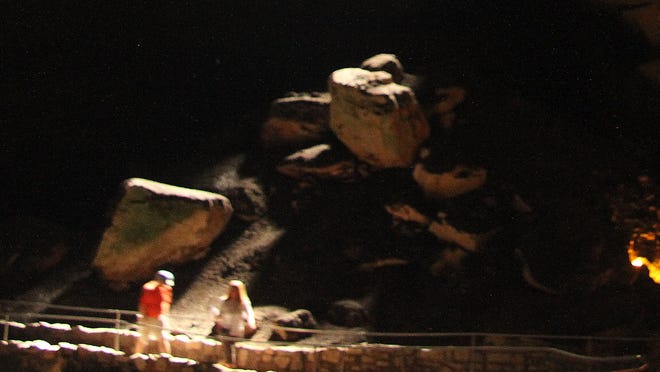Carlsbad Caverns' bat guano mining history revealed by explosive removal from Ogle Cave
 Adrian Hedden
Adrian Hedden
A mission to remove potential explosives from a remote area of Carlsbad Caverns National Park revealed the cave system’s legacy of guano mining.
The National Park Service reported it removed six boxes labeled “blasting caps” from a remote area known as Ogle Cave on March 11. The boxes were believed to once hold explosives used to carve passageways in the cave to allow bat dung known as guano to be lifted to the surface.
More:Meet Carlsbad Caverns National Park's new superintendent Carmen Chapin
Guano was mined from Carlsbad Caverns in the early 20th Century, and used as a popular fertilizer as it is high in soil-enriching nitrates.
But to get the prized guano in Ogle Cave, miners had to descend its 180-foot mouth.
Park officials believe workers hoped to create a path using explosives that would bypass the steep exit. That project, per the Park Service, was never finished.
More:Carlsbad structure fire contained to one house despite winds greater than 40 mph Sunday

This recent mission saw teams from the Park Service hike 1.25 miles into the parks remote back country, along with bomb squads from the Bureau of Alcohol Tobacco and Firearms, Federal Bureau of Investigation, New Mexico State Police, Carlsbad Fire Department and Eddy County Fire and Rescue.
The teams rappelled down the 180 feet of the cave’s mouth, and then hiked for about 45 minutes to reach the boxes.
Using X-ray devices, the teams were able to determine there were no explosives remaining in the boxes and removed them from the cave.
More:Forest Service seeks 20-year block on oil and gas in cave system

Acting Chief Ranger and Incident Commander Laura Steele said the biggest obstacle of the operation was the rough terrain, along with a rare spring snowfall for New Mexico’s high desert environment.
“In most situations, when potential explosive materials are identified, access is relatively straightforward for an explosives team to assess and address the situation,” Steele said. "The difficulty of the terrain, weather and obstacles leading to the potential explosives created a unique challenge.”
She commended the array of agencies that worked together to ensure the cave was safe not only for future visitors but would also continue to serve as an ideal place for bats.
More:Visit New Mexico's lesser known historic sites
“The level of cooperation between agencies during both the planning and execution of this incident was outstanding” Steele said. “We would not have been able to safely accomplish this mission without the teamwork of our partnering agencies.”

Carlsbad Caverns’ legacy of guano mining revealed by mission
Guano was once mined by the ton at Carlsbad Caverns. It’s estimated up to half a million bats call the iconic cave system home.
More:Explore the land of enchantment from home with state-wide virtual tour series
Experts estimate an average bat relieves itself 20-30 times a day, dropping a fecal “pellet” each time.
Those pellets gather by the thousands during a bat’s 20-year average lifespan, totaling roughly 180,000 pellets per bat.
Guano can be used to enrich soil and was the main agricultural fertilizer throughout the 19th Century, per a report from the National Museum of American History.
More:New Mexico's 'underrated' national parks offer unique experiences during fall hiking season
Records from the National Park Service show guano mining at the “Big Cave” within the caverns began in 1903.

That mining continued for about 20 years, as the guano was shipped mostly to southern California to fertilize massive citrus groves, per a report from the Public Broadcasting Service.
Use of Carlsbad’s guano was discontinued due to high shipping costs, per the report.
Another risk was the guano’s high nitrate content, like dynamite, which meant it could combust along the way.
More:Outdoor recreation suffered during COVID-19, showing signs of recovery in New Mexico
But for decades guano was mined and transported out of the cave system, with some of the remnants of that industry like the blasting caps still being found today.

And research of the guano itself continues, as scientists today believe it can help them learn about the more than 1,400 species of bats which account for 20 percent of all known mammals in the world.
Researchers from Northern Arizona University (NAU) collected bat guano from around the country to create the Species from Feces Assay published in 2016, which allows biologists to use fecal matter to determine where different bat species roost.
The assay, since being published, allowed researchers to pinpoint 92 percent of bat species and their roosts, per a 2019 university report, allowing wildlife managers to better understand local bat populations.
"Poop doesn't fly around in the dark and it's easy to collect," said geneticist Faith Walker, who also serves as co-director of NAU’s Bat Ecology and Genetics Lab. “Hence, the fecal method is friendlier to bats and us, and it gives a broader timeframe for the bat species that were using a roost."
Adrian Hedden can be reached at 575-628-5516, achedden@currentargus.com or @AdrianHedden on Twitter.